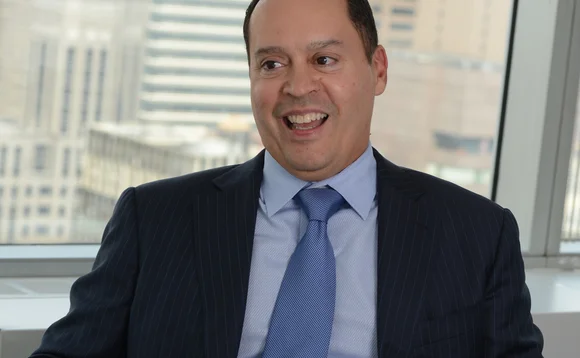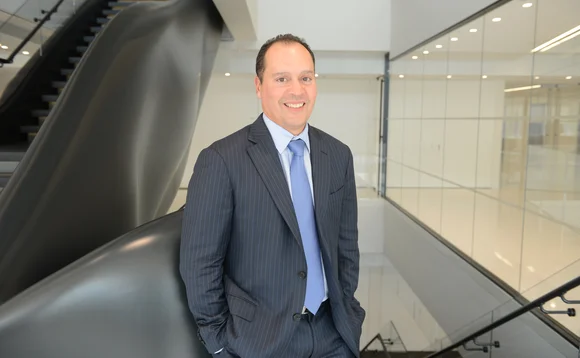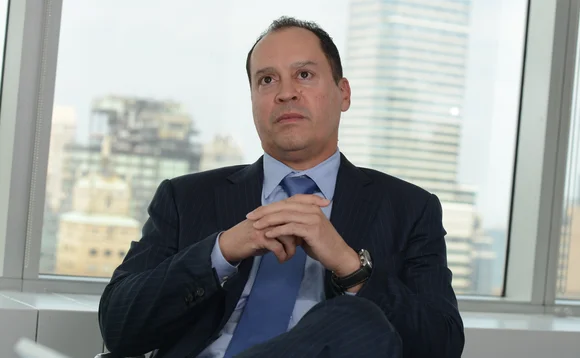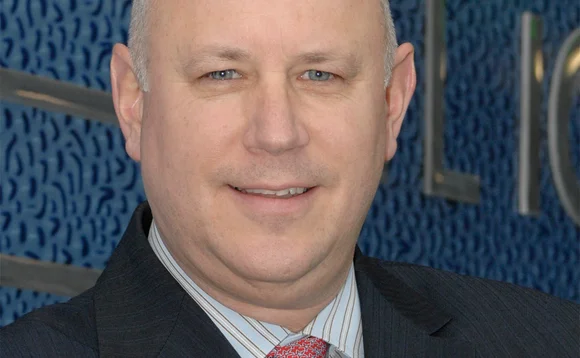Edwin Marcial: No More Mr. ICE Guy





Edwin Marcial opens his mouth, closes it again, and bites his breath as he ponders a prudent answer. He is a placid man, even-keeled on all subjects, even when the words hint at something felt but not shown. Reserve makes for good company spokesmen; Marcial’s face gives little away.
The unofficial motto of the Intercontinental Exchange (ICE) is, “Show, Don’t Tell.” When someone suggested a publicity campaign to announce the acquisition of the New York Stock Exchange (NYSE), the response was: “Why? We just bought ourselves $8 billion worth of free publicity.”
But Marcial is a proud man, and on the subject of ICE’s public perception, his blank expression can’t hide the fact that he wants to say something.
ICE was still a startup when Who Let the Dogs Out? was on the radio, so it is easy to graduate it today merely to “upstart.” It was a fair characterization in those early years, especially as the new company, a year after coming perilously close to going out of business, bought the powerful International Petroleum Exchange (IPE). But Marcial hints that those pants haven’t fit for a while. So ICE’s CTO chews on his thoughts for a few seconds before giving a diplomatic answer, something about how people have a right to think whatever they want.
It’s hard to see the “upstart” tag sticking much longer. ICE is close to owning the biggest equities market in the world—not just the business, but the history and the Wall Street address and the buttonwood tree and the trading pits and all the blue-blood stateliness that comes with it. Those who don’t deal in commodities and didn’t know anything about the Atlanta-based acquirer surely know it today. ICE is only getting into the country club now, but it has been one of the richest people in town for years.
“It’s all about getting it done, not about the process. It all goes back to that first year —just get it done, somehow; just make it work. It didn’t have to be perfect, and it wasn’t perfect.”
The Giant Nearly Dies in Its Cradle
CEO Jeff Sprecher, the new toast of Wall Street, is one of the only people who can match Marcial on first-hand knowledge of the company’s dizzying growth, and even he arrived after the man who would become his CTO. Marcial joined in 1996, before ICE was called ICE, because he wanted to make an imprint on a startup. He stayed when it shrank to nearly nothing in 1999, when its saviors arrived in 2000, and when it began challenging the Chicago Mercantile Exchange in the mid-2000s.
Born in New York’s East Harlem and raised in Miami, Marcial dabbled in medicine and mechanical engineering at the University of Florida before settling on computer science. After graduating in 1992, he joined the Harris Corporation, a mega company in nearby Melbourne, Florida, that did everything from telecoms and defense contracting to semiconductors. But when its monolithic nature kept his project—building industrial control systems for power plants—from seeing the light of day after four years, he left for the Continental Power Exchange (CPEX) in Atlanta.
Atlanta was bustling; the dotcom boom was fast turning it into a regional technology hub and the 1996 summer Olympics were a month away when he arrived. CPEX, a good-sized startup of around 30 employees, was designing systems for regional spot trading of power. By 1997, it was losing between half a million and a million dollars a month. Sprecher, a California power plant builder, needed technology to execute his ideas about the future of over-the-counter (OTC) energy trading, and bought the company virtually unseen.
“I didn’t do any due diligence,” he says. “The deal was that I had to buy the company and assume the liabilities and it was all going to be my risk. The former management team was not interested in having the company sold so they did not cooperate with me. I assumed the technology was good. Then I walked in the first day and Edwin said: ‘We want to completely redo everything using Oracle and Java.’ So the people who wrote the code essentially rejected the code and wanted to start all over again in a completely new language with completely new architecture. It was in a pretty bad state.”
Marcial told Sprecher that the entire IT team would resign unless their requests to program in Java, use Oracle databases, and embrace the emerging internet, were met. It was not what Sprecher had in mind for his first day. He responded by promoting Marcial.
Over the next two years, CPEX tore down and rebuilt its entire technology stack, losing every customer it had in the process. The payroll was trimmed to six people, including a bookkeeper and a secretary. An increasingly glum Sprecher was funding the entire operation out of his own pocket. Marcial hung on despite job offers from a growing number of technology companies, including Healtheon, which later merged with WebMD, because he still saw his chance to craft a platform in his preferred image.
In November 1999, energy giant Enron dealt CPEX what appeared to be a death blow, but turned out to be its big break. EnronOnline was an internet-based commodities trading platform that replicated what CPEX was trying to do; in fact, Enron representatives had engaged in technical discussions with CPEX staff before the startup realized that Enron was fishing for information for a competing product. EnronOnline stole whatever thunder CPEX had left. Yet, it also validated the business model, while spooking other power companies—EnronOnline forced traders to buy and sell to Enron, not with each other.
Buoyed by a New Year’s resolution to see their sputtering startup sink or swim for good, Sprecher and CPEX president Chuck Vice redoubled their sales effort in January 2000 and found a more receptive audience. Enron ranked number one among global energy concerns; most of the rest of the list signed up to trade power and natural gas on the CPEX platform. At the same time, Goldman Sachs, Morgan Stanley, BP, and others contracted with CPEX for OTC oil and metals trading. Sprecher gave away 80 percent of his equity stake in return for their commitments.
“It was shocking,” says Marcial. “We’d been running in Atlanta in a tiny office space that was barely keeping the lights on.”
Miraculous Growth
Virtually overnight, the rechristened IntercontinentalExchange (ICE) threatened to become the world’s largest online OTC energy market. The tiny IT group ate three meals a day at the office, leaving always after 10 p.m., in a desperate effort to meet the target launch dates. Marcial, named CTO that year, coded by day and interviewed programmer candidates by night. Fortunately, the system had been built with a generic architecture in order to handle different asset classes—Marcial had instructed his staff that it should be able to trade Furbies, a popular toy at the time. Still, something went wrong during every test, right up until the launch date. But on the big day, somehow, it all worked.
The next three years flew by at a breakneck pace. The staff was growing daily. Marcial’s team was patching the platform as fast as it could, starting with basic functionality and gradually moving on to performance upgrades. Enron’s accounting scandal in 2001 flooded ICE with even more business.
“It’s all about getting it done, not about the process,” Marcial says. “It all goes back to that first year—just get it done, somehow; just make it work. It didn’t have to be perfect, and it wasn’t perfect.”
Though the NYSE Euronext acquisition has been marked as the coming-out party, ICE’s 2001 purchase of IPE may have been a bolder stroke, considering the mad scramble that was still going on inside ICE offices. Based out of a London trading floor with no electronic operation, IPE was older, bigger, and more organized. It gave ICE a foothold in open market oil futures, a market dominated by the New York Mercantile Exchange (Nymex).
In 2005, ICE went public. In 2007, it bought the New York Board of Trade (Nybot), which provided two important additions: exposure to agricultural commodities; and clearing technology. ICE had used an external clearer previously. Today, clearing is a big part of its business.
It now longed to provide clearing for Liffe, NYSE’s London-based derivatives business. That was a motivating factor behind a 2011 hostile takeover attempt that would have handed Liffe to ICE and the NYSE equities exchange to Nasdaq. The bid was abandoned after the US Justice Department suggested that NYSE–Nasdaq would have created a monopoly. A year-and-a-half later, ICE had gotten big enough to make the buy without Nasdaq’s money. Announced in December 2012, the $8.2 billion takeover of NYSE Euronext appears close to gaining full regulatory approval.
Marcial is allowed to hold discussions with his NYSE counterparts, but not to move forward with any integration until the deal is completed. For compliance reasons, he is tight-lipped about the integration plan, although he was permitted to release a few details. The combined entity will keep two trading platforms: one for commodity derivatives and the other, the Universal Trading Platform (UTP) that NYSE sells to global exchanges, for equities and options. Analysts have speculated that Euronext will be sold off; Marcial confirmed that, from a technology standpoint, it is not an entity important to the parent company. There is also talk that NYSE Technologies, the exchange’s vendor arm, will be reorganized or significantly downsized. “There’s some good stuff in there and there’s the stuff we’re still not sure about,” Marcial says. “ICE has never been in the business of being a technology company for technology’s sake—we’re a technology company for the sake of operating our markets and our clearing platforms but not for the sale of technology. So that’s a new thing for us to get a grasp on.”
Driven by Rivalry
ICE’s corporate culture remains proudly one of making decisions on the fly, forged by that first manic year. It’s how Marcial has always operated his department, which today boasts 300 employees. Taking responsibility for the NYSE may force him to temper that aggressive, seat-of-your-pants approach. “In the early days of our company, it didn’t matter if we took a technology risk and it didn’t work out,” says Sprecher. “But today we set the world’s oil price and we’re soon to be operating the biggest capital markets in the world. Any little hiccup we have in technology could be on the front page of the newspaper. Edwin’s mandate is to not allow us to lose the calculated risk-taking and innovation that got us to where we are, but to do so in a way that respects the fact that we cannot make mistakes. We have to have 100 percent accuracy in what we do going forward.”
Marcial operates like an athlete. He plays third base for the Atlanta Cigars of the Men’s Amateur Baseball League—a league that includes former minor league professionals—and cares enough that he came to New York for a batting lesson, won in a contest, with Mets All-Star David Wright. He carries his competitiveness to the cubicle, taking disrespect personally in the way that coaches inflate bulletin board material as a motivational tool.
When ICE bought IPE, it bothered him that the media didn’t recognize what a coup it was. When Nymex opened a trading floor in Dublin to steal all the IPE pit traders who resented ICE’s all-electronic model, he doubled down on the electronic platform. Where once it had handled a paltry 13 transactions per second, he upped its capability to thousands per second. Today it does millions. Nymex, rapidly losing market share in oil contracts, embraced electronic trading in 2006 through CME’s Globex platform, but it was too little, too late. It was bought outright by CME two years later.
CME replaced Nymex as the hated rival. The two fought over the right to buy the Chicago Board of Trade (CBOT) in 2007. During that battle, ICE’s technology was scoffed at by some as incapable of meeting the latency needs of CBOT customers. The CME’s was still considered the gold standard. So Marcial kept shaving off milliseconds, going so far as to move ICE’s datacenter from Atlanta to Chicago to cut 30 milliseconds. He was determined to pass the CME, not only in speed but in stability, ease of connectivity, and every performance metric his system had ever been criticized on.
“I had a chip on my shoulder because they had been badmouthing us for years—them and Nymex,” he says. “So I wanted everybody to know we were running circles around them.”
Marcial’s words, however, don’t match his tone—flat and sober, as if he were relating someone else’s feelings rather than his own. He comes off like the stoic industry veteran he wants to be, but he thinks like the kid brother who believes he’s never getting enough respect. He’s caught in the same limbo as his company—slave to a growth spurt that confuses everyone’s perception of its place in the financial world, including its own.
Whatever ICE is thought to be—upstart, player, powerhouse—it is an exchange titan with a $13 billion market capitalization. Little more than a dozen years ago, that number was roughly $13 billion smaller. Marcial will take that over a big reputation any day.
EDWIN MARCIAL FUNDAMENTAL DATA
Name: Edwin Marcial
Title: CTO, IntercontinentalExchange
Tenure: Joined ICE in 1996, became CTO in 2000
Number of Staff: About 300
Education: BS in Computer Science from the University of Florida
Activities: Playing in the Men’s Amateur Baseball League, on a team called the Atlanta Cigars
Favorite Sports Team: New York Mets baseball team
Only users who have a paid subscription or are part of a corporate subscription are able to print or copy content.
To access these options, along with all other subscription benefits, please contact info@waterstechnology.com or view our subscription options here: http://subscriptions.waterstechnology.com/subscribe
You are currently unable to print this content. Please contact info@waterstechnology.com to find out more.
You are currently unable to copy this content. Please contact info@waterstechnology.com to find out more.
Copyright Infopro Digital Limited. All rights reserved.
As outlined in our terms and conditions, https://www.infopro-digital.com/terms-and-conditions/subscriptions/ (point 2.4), printing is limited to a single copy.
If you would like to purchase additional rights please email info@waterstechnology.com
Copyright Infopro Digital Limited. All rights reserved.
You may share this content using our article tools. As outlined in our terms and conditions, https://www.infopro-digital.com/terms-and-conditions/subscriptions/ (clause 2.4), an Authorised User may only make one copy of the materials for their own personal use. You must also comply with the restrictions in clause 2.5.
If you would like to purchase additional rights please email info@waterstechnology.com
More on Emerging Technologies
Waters Wavelength Ep. 313: FIS Global’s Jon Hodges
This week, Jon Hodges, head of trading and asset services for Apac at FIS Global, joins the podcast to talk about how firms in Asia-Pacific approach AI and data.
Project Condor: Inside the data exercise expanding Man Group’s universe
Voice of the CTO: The investment management firm is strategically restructuring its data and trading architecture.
BNP Paribas explores GenAI for securities services business
The bank recently released a new web app for its client portal to modernize its tech stack.
Bank of America and AI, exchanges feud with researchers, a potential EU tax on US tech, and more
The Waters Cooler: Broadridge settles repos in real time, Market Structure Partners strikes back at European exchanges, and a scandal unfolds in Boston in this week’s news roundup.
Bloomberg rolls out GenAI-powered Document Insights
The data giant’s newest generative AI tool allows analysts to query documents using a natural-language interface.
Tape bids, algorithmic trading, tariffs fallout and more
The Waters Cooler: Bloomberg integrates events data, SimCorp and TSImagine help out asset managers, and Big xyt makes good on its consolidated tape bid in this week’s news roundup.
DeepSeek success spurs banks to consider do-it-yourself AI
Chinese LLM resets price tag for in-house systems—and could also nudge banks towards open-source models.
Standard Chartered goes from spectator to player in digital asset game
The bank’s digital assets custody offering is underpinned by an open API and modular infrastructure, allowing it to potentially add a secondary back-end system provider.







